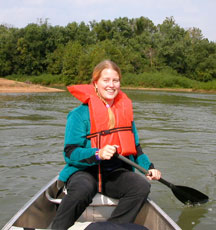 |
 |
|
 |
 |
 |
 |
 |
|
 |
 |
 |
 |

 |
 |
 |
 |

|
 |
Return to Table of Contents
 |
|
Brown-MBL environmental sciences student Gillian Galford
|
|
Brown, MBL Welcome New Students to Graduate Program
Affiliation flourishes as joint appointments, faculty collaborations grow
With the addition of three new graduate students and the tally of approved or soon-to-be-approved faculty appointments climbing, the Brown-MBL Graduate Program in Biological and Environmental Sciences has experienced robust growth since its creation less than two years ago. The affiliation unites MBL and Brown University’s combined research and education expertise in biology, biomedicine, and environmental sciences and not only offers talented graduate students the chance to work with scientists at both institutions, but also provides a ripe environment for faculty exchanges and research collaborations between the two institutions. “Progress so far has been very productive,” says William Beers, MBL’s chief academic and scientific officer. “Things have gone remarkably smoothly, and both Brown and the MBL are enthusiastic about where the relationship is going.”
“Things have gone remarkably smoothly, and both Brown and the MBL are enthusiastic about where the relationship is going.”
— William Beers, MBL’s chief academic and scientific officer |
First-year graduate students Erica Lasek-Nesselquist, Gillian Galford, and Lorin Jakubek are the newest additions to the program, and are currently focusing their studies at Brown.
Lasek-Nesselquist is working with David Rand, a professor in Brown’s Department of Ecology and Evolutionary Biology. She is studying the evolutionary development and advantages/disadvantages of hermaphroditism using barnacles as a model system. At the MBL she plans to explore genomic evolution of microbial eukaryotes under the leadership of Bay Paul Center director Mitch Sogin.
Galford is working in the field of terrestrial remote sensing with Brown associate professor of Geological Sciences Jack Mustard. At the MBL, she is collaborating with Ecosystems Center co-director Jerry Melillo to use remote sensing as a tool to understand temporal and spatial patterns of land cover and land use change in a region of southwestern Brazil.
Jakubek is a student in the Department of Molecular Biology, Cell Biology and Biochemistry (MCB) at Brown. She is currently in a rotation with professor Justin Fallon, who has joint appointments in Brown’s Neuroscience and MCB departments. Jakubek plans to study dystrobrevin, a gene involved in muscular dystrophy, and is in the process of determining who she will work with at the MBL.
Galford, Jakubek, and Lasek-Nesselquist join fourth-year student April Shiflett and third-year student Justin Widener who are part of the MBL’s Global Infectious Diseases Program, conducting their research in Stephen Hajduk’s laboratory. Shiflett and Widener focus their work on the parasite that causes human trypanosomiasis or African sleeping sickness, a fatal parasitic disease that has reemerged as a major health problem in sub-Saharan Africa.
Brown and MBL expect another five students to enter the graduate program this fall as the two institutions ultimately work toward a fully subscribed program of approximately 25 students.
The Brown-MBL affiliation is not only providing a one-of-a-kind training experience for graduate students, but is also enabling MBL investigators and Brown faculty to pursue joint appointments at the two institutions. “This relationship has led to a much higher level of research collaboration between scientists at the two institutions,” says Beers. He adds that by this summer, 20 MBL scientists will have approved Brown faculty appointments. Four Brown faculty are in the process of obtaining MBL scientific appointments.
“A joint appointment for an MBL faculty member means that he or she could serve as a mentor for a student in the joint program,” says Beers. “It also means MBL scientists could offer up a course at Brown.” Scientists in the MBL’s Ecosystems Center are developing two new courses for 2006. Senior scientist Ed Rastetter will teach an ecosystems modeling course at the MBL during the Brown intersession next January. The emphasis of the class will be hands-on experience building models, according to Rastetter. “The students will build about eight models during the three-week class, then build their own model as a term project to be carried out over the spring semester,” he says. In addition, Ecosystems Center scientists, in cooperation with colleagues at Brown, are developing a course for advanced undergraduate and graduate students that will focus on human impacts on ecosystem functioning. That course will be taught at Brown by a team of Brown faculty and Ecosystems Center staff during the spring 2006 semester.
Mitchell Sogin and his colleagues at the Bay Paul Center are also busy creating a course titled “The Molecular Biology and Evolution of Parasites” that they hope to offer at Brown in spring 2006. The intensive course will cover principles of molecular evolution, genomics, protistan parasites, endosymbioses, molecular biology of parasites, RNA editing, and gene expression, and is being designed to include weekend laboratory courses at the MBL. Sogin hopes that the course might serve as a common meeting ground for Brown students studying in the Pathobiology, Molecular Biology, Cell Biology and Biochemistry, and Ecology and Evolutionary Biology departments.
|
|
| |
 |
|
 |
 |
|